Triathlon and Multi-Sport Distances, A complete guide from IRONMAN to Olympic, Sprint & Multi-Sports
 Karen Parnell
December 14, 2021
Karen Parnell
December 14, 2021
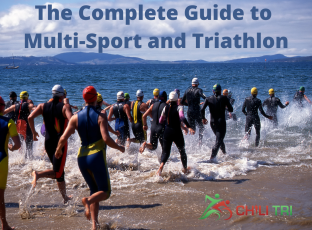
Triathlon and Multi-Sport Distances, A complete guide from IRONMAN to Olympic, Sprint and other multi-sports
The definitive guide for triathlon beginners plus those wanting to try multi-sport events aquathlons, duathlons, aquabike, XTRERRA off-road and SwimRun events
Triathlon is a great sport and offers many advantages over single sports. Firstly, it is a challenge and very rewarding both during training and when you cross the finish line of your first event (plus the many you will do after as it is addictive!). Unlike single event sports you will naturally “cross train” which mean you will be less likely to over train or get injured. Training for three sports will also mean training will always be interesting and varied.
Another great thing about triathlon is that however much time in your busy you have to train there is a distance for you. You can also go off-road with events like Xterra or triathlon cross.
We will cover all of the distances and modes from triathlon, aquathlon, duathlon, aquabike to triathlon cross distances.
Triathlon is for everyone and prides itself on equality and diversity. Male and female athletes cover the same distances.
Triathlon Distances
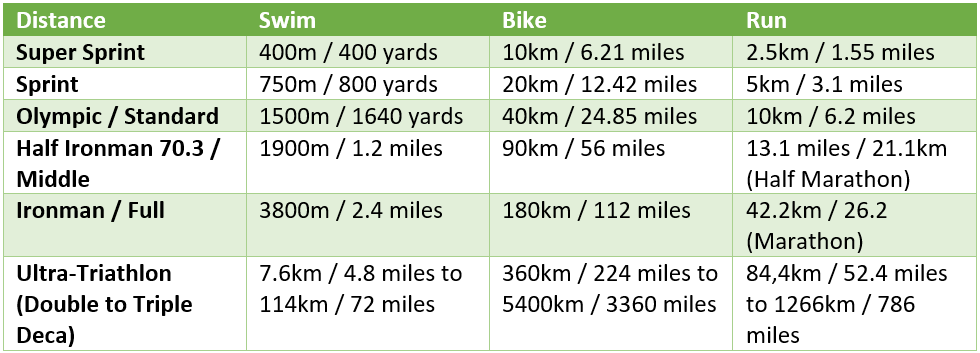
Table 1: Super Sprint, Sprint, Olympic, Half Iron, Full Iron, T100 and Ultra triathlon distances
Triathlon is a multi-discipline sport consisting of swimming, cycling and running, and is a great sport to keep active. Plus, by taking on the three disciplines, you can keep training fun and varied too! Contrary to some a triathlon is not just an Iron distance events but includes super sprint, sprint, Olympic or Standard, Half or Middle, Full or Iron and Ultra distance events. There is really something for everyone! You can even do some events as a team or relay so you can choose to do either the swim or bike or run leg. There are other formats for a relay event and in the Olympics, there is a mixed team, and the distances are a 300m swim, 7.2km bike and 2km run. The Mixed Team Relay format is held in Female-Male-Female-Male order, with each athlete completing a short swim-bike-run effort, before tagging their team-mate. Exact distances may vary slightly between events. It is predicted that this format will extend to all levels of the sport so exciting times ahead!
The Olympic or Standard distance is the event featured at the Olympics and the professionals do the race in around 1:45 (Men) and 1:55 (Women). There are Age Group (AG) races for everyone and expect to do the event in around 3 hours. If you are fast for your Age Group, you can qualify to represent your country are European and World Championships, so this really is an exciting sport!
Most people start with a swimming pool based Super Sprint event or an open water-based Sprint event. You may choose to stick with this distance or move to a longer event like a Half IRONMAN or IRONMAN distance event. IRONMAN is a brand for the longer events but there are other events with similar distances you can choose from.
FREE 31 structured bike workouts for Zwift, Rouvy and TrainerRoad with Printed workouts - ideal for Base Training
For most iron-distance triathlon races, there are strict cut-off times in place in order to finish. For the full Iron distance there will be a cut-off time for the swim (usually around 2 hours 20 minutes), a cut-off for the Bike (usually 10 hours 30 minutes) and an overall cut-off time which is usually 17 hours. You will need to check your race pack for the exact details. Cut offs are also usually in place for the Half Iron distance events.
Right now, the fastest ever Ironman time is owned by Norwegian Kristian Blummenfelt, who clocked an astounding 7:21:12 at Cozumel in November 2021.
Get your FREE swimming workouts for triathletes book here.
We have triathlon training plans on TrainingPeaks and Final Surge.
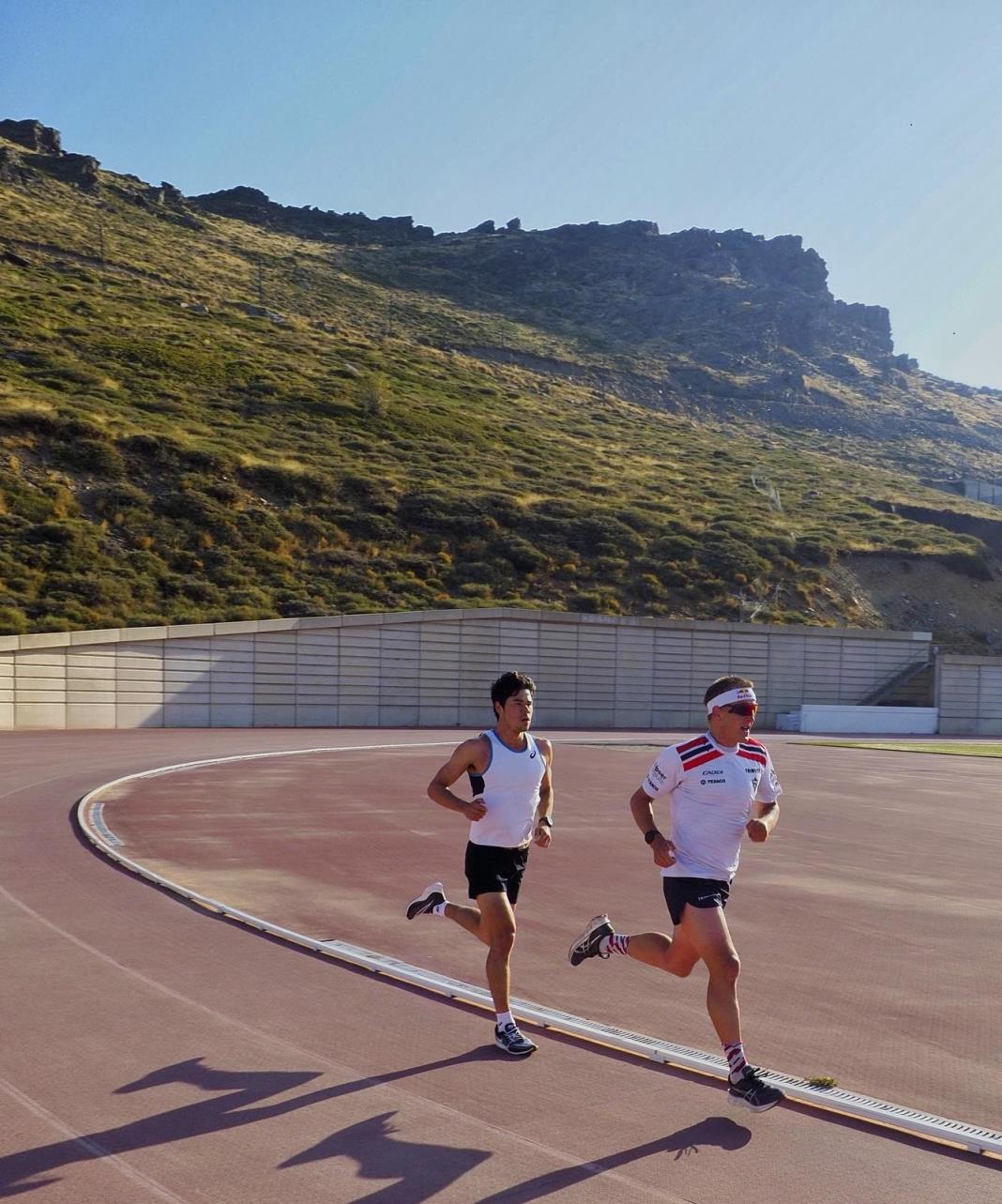
Kristian Blummenfelt training at the high altitude centre in the Sierra Nevada mountains in Spain near where I live. He was preparing for Cozumel
Get your FREE Guide to Running Speed and Technique
Most competitors can expect to finish a full Iron Distance events in around 10 to 14 hours.
If you want to really go long there are Ultra Triathlons. An Ultra Triathlon is a type of race that uses multiples of the classic long distance, as it was first held in 1978 in Hawaii. This long distance includes a swim of 2.4 mi / 3,8 km, a bike ride of 112 mi / 180 km and a marathon run in that order without a break. These events go from double to triple deca (30 Iron distance events!).
Triathlon Relay Races
If you want to do a triathlon but can't do all of the disciplines due to injury or other reason then a great one to experience the thrill of triathlon is to do it as a relay team. This is great for friends or family to spread the legs over three people with one doing the swim, one doing the bike leg and one doing the run to finish the race. Most events offer relay entries which are also popular for charity challenges.
Get your FREE swimming workouts for triathletes book here.
Duathlon Distances

A duathlon is a run, bike, run format. Usually, the second run is half the distance of the first. So, for instance, a sprint distance will be 5km/20km/2.5km and a standard distance duathlon will be 10km/40km/5km on the road. Off road duathlons are usually nearer to a sprint distance, with either a mountain bike or cyclocross bike being suitable for this terrain.
Get your FREE Duathlon Training Plan
We have duathlon plans on TrainingPeaks and Final Surge.
Aquathlon Distances

The sport of aquathlon consists of a continuous, two-stage race involving swimming followed by running but in some countries they also so a run/swim/run sandwich. The International Triathlon Union and its member federation organizations sanction competitions and govern the sport. An aquathlon is also called an "aquathon." The ITU and USA Triathlon sanctioning organizations generally use the term aquathlon.
Get your FREE swimming workouts for triathletes book here.
We have Aquathlon training plans on TrainingPeaks and Final Surge.
ITU Aquathlon

For the ITU an aquathlon is one of the simplest and most accessible forms of multisport, aquathlon consists of three legs, with a swim sandwiched between two run segments. The official distances for the annual ITU Aquathlon World Championships are a 2.5km run, 1km swim, and 2.5km run. This can change if the water temperature is lower than 22 degrees, in which case the race becomes a 1km swim followed by a 5km run.
Aquathlon is an excellent way for novice athletes to enter the world of multisport, and for experienced triathletes to add something different to their race routines.
There are a wealth of aquathlon races organised throughout the year of varying distances and forms. During the colder months, pool-based aquathlons are often held using the swim-run formula. During the summer, evening and weekend aquathlon race series are held by many triathlon clubs. Junior and youth races are also held (although with shorter swim and run distances dependent on age) in both pools and open water.
At the 2019 ITU Multisports World Championship Festival in Pontevedra, Spain, it was Azerbaijan’s Rostislav Pevtsov and Alicja Ulatowska of Poland who took the Elite golds. You can find the full results here.
Get your FREE swimming workouts for triathletes book here.
USA Aquathlon Distances

The run can take place on a trail, a road or a path. It just depends on what the course calls for and where it is located. Similarly, the swim can take place in any body of water – a pool, a reservoir, an ocean, etc.
Some aquathlons are designed to help endurance athletes train for bigger multisport races and improve their swim/run transition or open water swim times while others are designed for athletes who are just getting into the multisport lifestyle and want to “get their feet wet” in the sport.
Who Competes in Aquathlons?
As far as ITU Aquathlon World Championships, eligibility is granted to many stand-out pro triathletes, under 23 athletes and junior athletes. On a national level, aquathlons are gaining popularity among many athletes who want to challenge themselves athletically and improve their endurance but are not interested in the biking leg of triathlons. Whether you are afraid to ride without training wheels, cannot afford a bicycle, or are sick of the saddle sores and road rash that come along with hours of cycling training, aquathlon offers solutions to all these problems.
Possibly some of the most attractive aspects of this sport are that the race distances are short so less training time is required, equipment needs are minimal and it is a fairly inexpensive sport to get into.
Aquathlons are also quite appealing to race directors because it not only reduces the logistics by removing one of the legs from a triathlon, but it also reduces the amount of space needed to hold a race. As a result, competitors can race in a smaller, more manageable environment.
Get your FREE Open Water Swimming Sessions E-Book
Getting Started
As mentioned earlier, very little equipment is needed to compete in an aquathlon – athletes will need a swimsuit, goggles, a cap, running shoes and motivation to train and compete.
Triathlon race directors around the world are beginning to respond to the demand of athletes interested in the run/swim combination by offering aquathlons in conjunction with the triathlons they are putting on. It is not uncommon to find a triathlon that also has an option for duathlon or aquathlon.
Get your FREE swimming workouts for triathletes book here.
Aquabike Distances

Aquabike is a swim and bike combination race. They vary in length but the most common distance, as well as the USAT National Championship distance, is a 1.2-mile swim and a 56-mile bike. Aquabike races are becoming popular with race directors as they can put on a triathlon and aquabike easily and use the first two legs of triathlons. These are very popular with people who may have retired from running due to injury but still want to compete in multi-sports.
Companies like Active Training World try to include Aquabike events at their events to ensure more people can enjoy multi-sport events.
Aquabike races are now appearing at the Europe Triathlon Multisport Championships which will be in Bilbao 2022 so you can represent your country at Age Group events.
Read more about Aquabike here.
FREE 31 structured bike workouts for Zwift, Rouvy and TrainerRoad with Printed workouts - ideal for Base Training.
We have Aquabike training plans on TrainingPeaks and Final Surge.
Xterra / Triathlon Cross / Off-Road Triathlon Distances
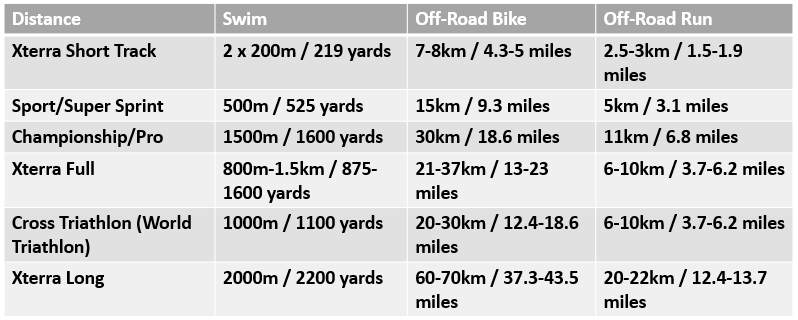
Cross triathlon, or X-tri, is an off-road triathlon discipline that typically takes place over a 1km swim, 20-30km mountain bike and 6-10km trail run.
The discipline first emerged in 1996 at a race in Maui, Hawaii, before evolving into the world-renowned XTERRA series.
After four years of continental championships, ITU held its first Cross Triathlon World Championship in April 2011 in Extremadura, Spain, at the ‘Ring’ complex. Since then, champions have included Bermuda’s Flora Duffy and Mexico’s Francisco Serrano, who won the title at the inaugural World Multisport Championships Festival in Penticton, Canada in 2017.
At the Pontevedra 2019 World Multisport Championships, Arthur Forrisier of France and Italy’s Eleanora Peroncini were crowned champions, and you can find the full results here.
In 2022 introduced the Xterra long format, distances will vary slightly between locations; however, each event will include around 2km of open water swimming, 60-70km off-road riding, and 20-22km of trail running.
Another notable difference from other XTERRA race formats is the addition of bike options. Unique to the XTERRA Long Distance format, gravel and cyclocross bikes will be allowed alongside mountain bikes, giving competitors more choice when it comes to tackling the terrain of each location.
FREE Trail Running 8-Week Training Plan
We have Xterra and off-road triathlon plans on TrainingPeaks and Final Surge.
ÖTILLÖ and SwimRun Events
ÖTILLÖ Distances

SwimRun events are very exciting and certainly fun. The distances may look short but don’t underestimate how much energy you expend getting into and out of the water so your times may be a lot slower than you predict! Training is different as well as you will need to do various combo session to simulate the in and out of the water.
A “SwimRun” is a multiple-stage competition which involves participants running and swimming over a racecourse that involves multiple swimming and running stages. Typically, participants do not change clothing in transitions as in other multi-sports such as triathlon.
ÖTILLÖ is the original SwimRun race, it is The SwimRun World Championship. To finish the ÖTILLÖ course from dawn to dusk, the competitors must be very fit, and they must be very fast in and out of the water as there are 46 transitions. The teams swim between the 24 islands and run over them. The total distance is 75 kilometres of which 10 km are open-water swimming and 65 km are trail-running.
Those taking part can use paddles and pull buoys to make the swim section achievable in full running kit and running shoes.
The are other SwimRun events around the globe that are not ÖTILLÖ events and the race levels vary from country to country. There are no set race limits or race standards apart from having to compete in twos (some events allow solo participants now) and as to what is constituted as a SwimRun race. Currently the majority of races (2018) are spread among the following levels below.
The world standard SwimRun distances are divided into 6 types, in accordance with the majority of available races including ÖtillÖ.
Merge between team and individual distance since 2019

Source: Wikipedia
Most SwimRun events now offer the option to do the event as a solo for the shorter races. They are highly variable in distances as they depend on the geography but the total distances above follow a theme.
Here´s an example of an event in the Costa Azahar, Spain:
Distance: Half or 17km total as 4.5km swim and 11.5km run. As you can see the distances are variable and this is a called a Half distance by the organisers even though it could also be considered a Sprint!
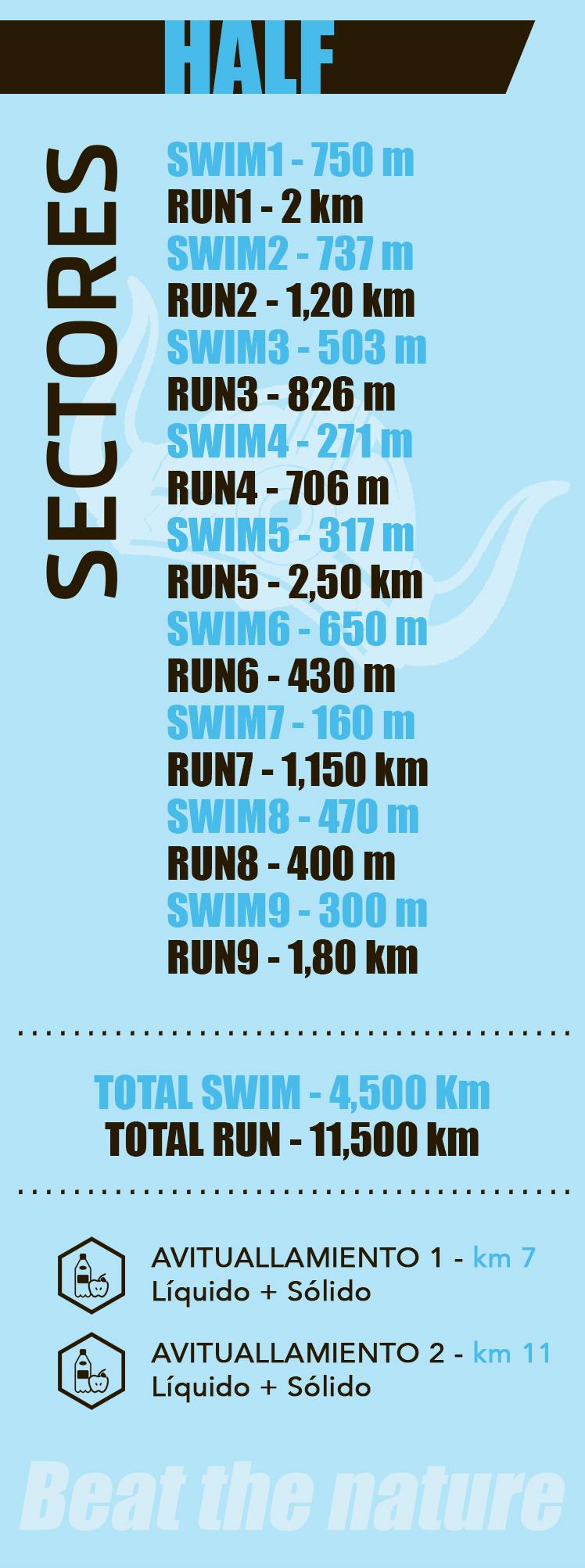
Get your FREE swimming workouts for triathletes book here.
We have SwimRun training plans on TrainingPeaks and Final Surge.
Triathlon and Multi-Sport FAQ
1.Do you have to swim front crawl in triathlon?
It is the preferred stroke as it tends to be the fastest, but you can use breaststroke as long as you know you will meet any event cut off times. But it´s worth noting that in the British Triathlon rules is says “Backstroke is not permitted in pool swims; any competitor wishing to use backstroke at an open water event must indicate this to the Event Organiser before entering the water.” Backstroke in open-water races can sometimes indicate you are in trouble and can also lead to some sighting issues though. You should always read the race rules before any event as some events have special rules due to local safety regulations.
2. Are open water goggle different for pool goggles?
You can use pool goggles in open water but try them out before race day for leaks, fog and sunlight. Open water goggles do tend to come with larger lenses, which therefore provide better peripheral vision. The other area to consider is the lens tint, to cope with the different lighting conditions outdoors.
3. What are Transitions?
Transition is used a lot in triathlon and means the area where you store your bike during your swim and run leg and also your running shoes and other kit you will use during your race. It also refers to Transition 1 or T1 and Transition 2 or T2. T1 is where you transition from the swim to the bike leg and T2 is from bike to run. Some time people call this the forth discipline in a triathlon.
4. What are Brick or Combo Sessions?
Brick sessions are where you stack bike, run or swim sessions together. A traditional Brick work out is a Bike to Run session where you practice changing as quickly as you can and start to learn to cope with “wobbly legs” when you transition from the circular motion of the bike to the up down movement of the run. You can do Run to Bike combo sessions to help with Duathlons or run-bike-run or swim-bike-run or any combination to help practice your race strategy and technique.
5. Is there a minimum temperature that requires athletes to wear wetsuits?
According to British Triathlon rules state:
“The use of wetsuits is forbidden or mandatory if the following combinations of distance and water temperature are attained:

*when mandatory, the wetsuit must cover at least the torso
Although rule 4.3 also states that “at temperatures below 11°C it is recommended that open water swimming does not take place.”
But again, read your event rules to see if there are local conditions that change this.
6. How do you get out of a wetsuit quickly?
Undo your zipper fully, remove from your shoulders and pull each arm out one at a time. You can run to transition with out at waist height. Then pull your wetsuit down so that it’s below your knees. Step out of one leg, and tread on the wetsuit to help pull the other leg out.
It´s worth practicing your transitions before race day as this can add seconds and even minutes to your race.
7. How do you look after a wetsuit and the best way to store a wetsuit in the off-season?
Whether you are swimming in the sea or lake or river it´s best to rinse your wetsuit off in clean fresh water after every swim. This ensures it´s clean for your next swim but also stops taking unwanted critters to other locations. For example, in Spain some lakes have a mussel which is not good for the lake or environment and there are signs around the lake asking sailors, fishermen and swimmers to wash their kit before leaving the lake. Store your wetsuit inside out when dry and away from direct sunlight and on a soft hanger. If storing it for a long time make sure it´s not a damp area.
8. I’m not a strong swimmer and hate people swimming near me in the open-water. How can I avoid being nudged?
Stay over to one side of the pack or at the back if you’re not racing competitively. If there’s a buoy turn involved, work out your route prior to the start and stay to the outside of that to avoid a squishing. Also remember that it’s all part of the racing experience and no triathlete would put you at risk on purpose.
9. I´ve heard the term dolphin dive, what is it?
It’s a technique used to get through shallow water efficiently. It simply involves taking short shallow dives, standing up and repeating until you get deep enough to swim.
10. Can I wear a nose clip for the triathlon swim leg?
Yes, you can. The only other ‘aids’ you’re allowed include a cap, goggles and costume/wetsuit.
11. Can I use swim paddles and a pull buoy in a SwimRun event?
Yes, you can! SwimRun events are unlike other swim based multi-sport events you can use swim paddle and pull buoys as you will swim in your running shoes. Remember you need to carry everything you use the whole way round.
Get your FREE swimming workouts for triathletes book here.
FREE Trail Running 8-Week Training Plan
FREE 31 structured bike workouts for Zwift, Rouvy and TrainerRoad with Printed workouts - ideal for Base Training
TRANSITION
12. What are jelly legs exactly?
It’s the odd sensation you’ll experience in your legs as you move from one discipline to the next (swim to bike: bike to run) and as your body gets used to using different muscles and going from horizontal to vertical (swim to run) or from paddling a circular motion to a more piston like running motion (bike to run). Don’t worry these sensations will fade as you settle into your rhythm either on the bike or run.
13. What are the rules with regards to helmet wearing in T1?
According to British Triathlon “All competitors must have their helmet securely fastened from the time they remove their bike from the rack before the start of the bike leg, until after they have placed their bike on the rack after the finish of the bike leg.” Failure to do so may result in a time penalty.
BIKE
14. Apart from TT or aerobars, what else makes a tri-specific bike different from a road bike?
The biggest difference is the frame geometry. Usually that means shorter head and top tubes that you’ll find on a road bike, and a seat tube that’s closer to vertical. All this is to get your upper body lower and further forwards. This makes you more aero but also opens up your hip-leg angle to make it easier to run after the bike.
15. How can I work out my Functional Threshold Power (FTP?
Functional threshold power (FTP) is your maximum sustained effort over a 45-60 min period. You can work it out by performing a 20-minute bike test and calculating 95% of your average power output for the ride. You will need a power meter (or a sophisticated indoor trainer such as a Wattbike) to obtain these results. You can do a test described by British Cycling using the same 20-minute protocol but using a heart rate monitor instead to find your Functional Threshold Heart Rate (FTHR) if you don’t have a power meter.
You can also do an FTP test indoors on an indoor trainer and use Zwift, TrainerRoad etc and use their standard tests.
16. What’s the difference between clincher and tubular tyres?
The most common is the clincher, which consists of a tyre and an inner tube fitted into the clincher wheel’s rim. Tubs (or tubulars) is a one-piece system where the tube is sewn inside the tyre. You glue this onto the rim of a tubular wheel. You can pump tubs up to a higher pressure than clinchers, which potentially means more speed.
17. What’s the difference between turbo indoor trainers and rollers?
With a turbo indoor trainer, your bike is attached to it: rollers require you to balance on them. Both are ideal indoor trainers. You can also get smart turbo trainers that hook up to Apps like Zwift, TrainerRoad, Fulgaz etc and ride with other riders on courses and also follow structured sessions.
18. What cadence should I be averaging on the bike?
Everyone is different, but studies have shown that 90rpm is roughly a good figure to aim for. Having said this, your cadence can be affected by your physiology and bike set-up, among other things. Check you have the correct crank length – if it’s too short this could lower your rpm. Heavier athletes are usually more efficient at lower pedal speeds, whereas lighter riders will often have more slow-twitch muscle fibres that are suited to faster spinning.
RUN
19. I can´t afford a heart rate monitor, can I still train for a triathlon?
Yes, you can still train, and you may find using Rate of Perceived Exertion (RPE) to gauge the intensity of your training sessions. The Borg Rating of Perceived Exertion (RPE) is a way of measuring physical activity intensity level. Perceived exertion is how hard you feel like your body is working. It is based on the physical sensations a person experiences during physical activity, including increased heart rate, increased respiration or breathing rate, increased sweating, and muscle fatigue. These days we tend to use a scale of 1 to 10 rather than 1 to 20 like the Borg scale. Here´s an example table:

The Rate of Perceived Exertion (RPE) 1 to 10
20. When I’m running in heart rate zone 1, it feels really slow. Is that right?
Yes. Base training is all about keeping your heart rate down and building fitness, not about speed. So, you may well find that you’re running slower than usual but that means you’re doing it correctly!
21. What’s a negative split?
A negative split – most commonly used in relation to the run – is where you pace to make sure that the second half of the respective discipline is faster than the first. It’s a common tactic to ensure that you don’t go too hard too early and ‘blow up’ further into the race. It’s especially important if you’re not good at pacing yourself
22. What does the word overpronation mean?
When the feet roll inward too much on toe-off. Supination is the opposite, when the feet don’t roll inward enough. Go to a run/tri shop and they’ll be able to tell you what sort of gait you have and advise which shoes would suit you best.
23. Will doing off-road or trail running benefit me?
Running off road or trails is easier on the body, strengthens the core muscles due to variable surfaces, is more interesting than running on pavement and can include seriously steep hills. It will strengthen your core, hamstrings, glutes and quads and if running up and downhill will improve your running form.
24. I’ve been using energy gels, but I find them a bit sickly. Are there any alternatives?
Plenty of alternatives to energy gels have been touted, from marzipan to jelly babies. But the best bet maybe to go for something made by an energy manufacture, so consider trying Clif Shot Bloks (chewy energy blocks) or Lucozade energy tablets, both of which have different consistencies to gels.
INJURIES
25. I always feel guilty on rest days. how important are they?
Rest days are absolutely vital to a good training plan. Your body needs time to recover and rebuild after you push it hard in training. If you don’t allow your body to recover, you’ll accumulate fatigue, your performance will drop, and you may even end up injured. Make sure you take days off.
26. How can I avoid injuries in training?
There is no one way as accidents do happen. To help avoid injuries always warm up well with dynamic movements and drills and stretch out after your sessions. Incorporate strength and conditioning sessions into your training plan. Avoid over training and doing too much too soon. If you do find yourself injured seek out a professional as soon as you can to get the best treatment to recover well.
TRAINING
27. Can I do a triathlon without a training plan?
If you are new to triathlon or multi-sport you should try to join a local club so you can learn from other and get structured training. You will get great support, advice and motivation. You can get a training plan and some are free. There are other low cost professional training plan from platforms such as TrainingPeaks, Final Surge, Training Tilt etc. These are plan delivered via an App, which is usually free, written by professional coaches. These plans start at around €25. If you would like a more personal plan you can engage a coach and this coasts around €125 per month. Make sure you check out their qualifications and experience.
LONG-DISTANCE
28. In Ironman, what are the rules on outside assistance?
The rules state: “Friends, family members, coaches or supporters of any time may not bike, drive or run alongside an athlete, may not pass food or other items to an athlete and should be warned to stay completely clear of all athletes to avoid the disqualification of an athlete”.
29. How do triathletes go to the loo mid-Ironman?
There will be mobile toilets along the route for rest stops. Or, if you really can’t wait. you can simply pee in your tri-suit. This can cause chaffing so if you are not a professional it may be worth taking a few minutes to get off your bike or break up your run with a loo break.
Would you like a free training plan? Claim your free plan or e-book.
Would you like to talk about your training? Get in touch here.
Karen Parnell is a Level 3 British Triathlon and IRONMAN Certified Coach, 8020 Endurance Certified Coach, WOWSA Level 3 open water swimming coach and NASM Personal Trainer and Sports Technology Writer.
Karen is currently studying for an MSc in Sports Performance Coaching at the University of Stirling.
Need a training plan? I have plans on TrainingPeaks and FinalSurge:
I also coach a very small number of athletes one to one for all triathlon and multi-sport distances, open water swimming events and running races, email me for details and availability. Karen.parnell@chilitri.com
Get your FREE Guide to Running Speed and Technique
Get your FREE Swim Workouts for Triathletes E-book
Get your FREE Open Water Swimming Sessions E-Book
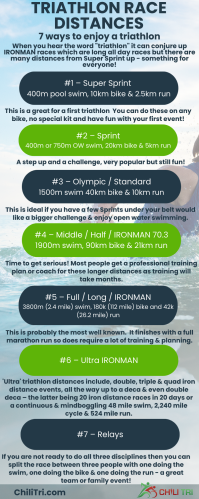
Infographic of The 7 ways to Race a Triathlon from Super Sprint to IROMAN and relays!
Get in touch for a PDF of this Infographic
Get your FREE swimming workouts for triathletes book here.
#chilitri #blog #triathlondistances #triathlonraces #aquathlon #aquabike #duathlon #swimrun #xterra #swimmingtrainingplan #cyclingtrainingplan #runningtrainingplan #swimming #cycling #running
